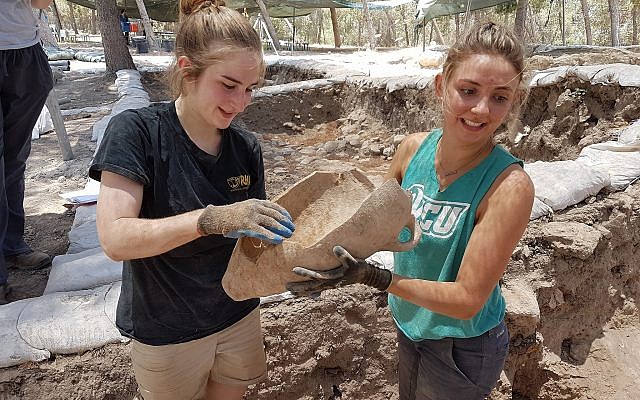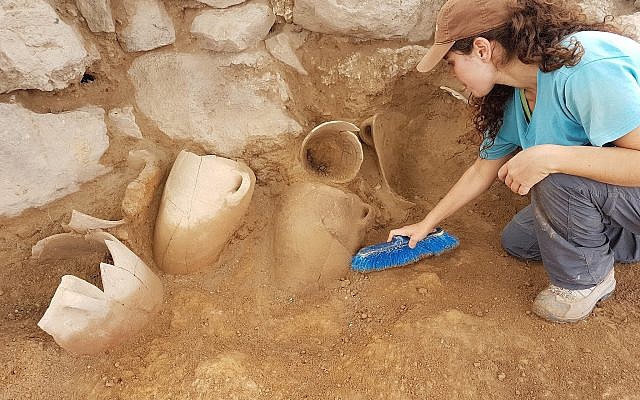Carbon 14 dating supports the archaeologists' identification
For decades scholars sought the elusive site of Ziklag, where the Bible says David was given shelter by Philistine King Achish

Volunteers
excavate pottery from Khirbet a-Ra'i, which archaeologists have
identified as biblical Ziklag. (Excavation expedition to Khirbet a-Ra‘i)
Based on artifacts and carbon 14 dating results of excavations since 2015, scholars proposed Monday that the archaeological site of Khirbet a-Ra‘i in the Judaean foothills is the site of the elusive Philistine town.
As attested in the books of Samuel, Ziklag, located between Kiryat Gat and Lachish, provided refuge to the future king David when he was on the run from King Saul. After his sojourn in Ziklag, David ascended the throne in Hebron.
According to a joint press release from the Hebrew University in Jerusalem and the Israel Antiquities Authority, archaeologists discovered remains of a Philistine settlement from the 12-11th centuries BCE, which was followed by a rural settlement dating to the early 10th century BCE, which is in keeping with the biblical account. Carbon 14 dating supports the archaeologists’ timeline and identification, according to the press release.

A volunteer excavates pottery from
Khirbet a-Ra’i, which archaeologists have identified as biblical Ziklag.
(Excavation expedition to Khirbet a-Ra‘i)
While the then-Philistine vassal David attempted to join the army of his Philistine lord Achish to defeat Saul, retaliating Amalekites razed the town and took off with the Israelites’ women and children, along with much booty. (Spoiler: In the end, David prevailed.)
According to the press release, in addition to the cultural transition between Philistine buildings and the presumed later Israelite camp, the Davidic-era settlement shows remains of an intense fire that destroyed it.
Later in the Hebrew Bible, in the Book of Nehemiah, the town is mentioned again as a base for Jews who returned from Babylon.

A volunteer excavates at Khirbet a-Ra’i,
which archaeologists have identified as biblical Ziklag. (Excavation
expedition to Khirbet a-Ra‘i)
According to leading archaeologists Prof. Yosef Garfinkel, head of the Institute of Archaeology at the Hebrew University in Jerusalem; the IAA’s Saar Ganor; and Dr. Kyle Keimer and Dr. Gil Davis of Macquarie University in Sydney, Australia, the proposed site of Khirbet a-Ra‘i has all the required qualifications.
The joint IAA and Hebrew University press release said that after seven dig seasons that uncovered some 1,000 sq.m., the archaeological team found evidence of a Philistine-era settlement from the 12-11th centuries BCE, among which were massive stone structures and typical Philistine cultural artifacts, including stylized pottery in foundation deposits — good luck offerings laid beneath a building’s flooring.
Those artifacts, along with stone and metal tools, are similar to ones found in other Philistine cities, including Ashdod, Ashkelon, Ekron and Gath.

Pottery assemblage from Khirbet a-Ra’i,
which archaeologists have identified as biblical Ziklag. (Excavation
expedition to Khirbet a-Ra‘i)
At Khirbet a-Ra‘i to date, archaeologists have uncovered some 100 complete pottery vessels used for storing wine and oil, among other uses. According to Garfinkel, who led excavations at the contemporary fortified Judaean city of Sha‘arayim (Khirbet Qeiyafa), jugs and bowls decorated with a “red slipped and hand-burnished” finish are typical of the period of King David.
No comments:
Post a Comment